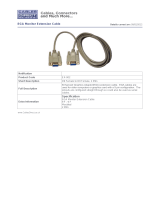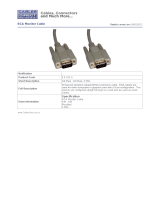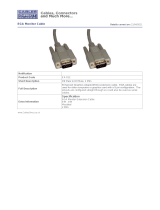Page is loading ...

USER
GUIDE
IMPACT 64
801.200A
USG/064/AE-A
14.06.95
Not the actual front page

USER GUIDE
IMPACT 64

USER GUIDE LCD PANEL
2

USER GUIDE LCD PANEL
3
TABLE OF CONTENTS
INTRODUCTION .....................................................................................5
MAIN FEATURES....................................................................................5
SUPPLIED MATERIAL.............................................................................6
OPTIONAL MATERIAL............................................................................ 6
SETTING UP THE LCD PANEL ...............................................................7
COMPUTER...............................................................................8
MOUSE......................................................................................9
USING THE LCD PANEL....................................................................... 11
REMOTE CONTROL................................................................ 11
FRONT PANEL ........................................................................ 13
CONNECTORS........................................................................13
FEATURES............................................................................................ 14
PRACTICAL HINTS AND TIPS............................................................... 18
MAINTENANCE.....................................................................................20
SERVICE............................................................................................... 20
TECHNICAL DATA ................................................................................ 21
CONNECTORS ..................................................................................... 24
FCC STATEMENT................................................................................. 25
ENVIRONMENTAL STATEMENT...........................................................26
SERVICE INFORMATION......................................................................27
CONNECTION LAYOUT........................................................................28
(Foldout Page)

USER GUIDE LCD PANEL
4
This publication is printed on recycled paper.
The information contained in this user guide is preliminary, and the products described
herein are subject to change without prior notice.
The symbols and are used in this publication to indicate
Warning and Note respectively.

USER GUIDE LCD PANEL
5
1 INTRODUCTION
The LCD panel is a state of the art projection device that can be connected
to most computers.
The ability to display a multitude of greyshades simultaneously, makes it
the ideal choice for presenting computer generated text and graphics.
Applications include presentations, software training, educational use,
advertising, information boards and other situations where a small or
large audience shares information.
2 MAIN FEATURES
- 64 greyshades
- BatMouse™, infrared remote mouse
- User settings memorized
- Individual settings for all modes
- Correct VGA text
- Infrared remote control
- Housing footprint fits OHP glass exactly
- Low weight
- Intelligent Safecool system
- False light blocking
- 4 meters Y-cable

USER GUIDE LCD PANEL
6
3 SUPPLIED MATERIAL
A complete set includes the following components :
1. LCD Panel 8. Power -5, 12, 5 V
2. VGA-Cable 9. Power Cable
3. Cable-Adapt. MACII mon 10. BatMouse Remote Control
4. Cable-Adapt. MACII comp. 11. Batteries
5. Mouse Cable 12. Attachè Case
6. Mouse Adapter PC 13. User Guide
7. Mouse Adapter Mac
4 OPTIONAL MATERIAL
Optional cables and adapters are available for special computer sources.

USER GUIDE LCD PANEL
7
5 SETTING UP THE LCD PANEL
Switch off all equipment before connecting the components. Be aware of
static electricity that may build up, especially in the dry season and when
operating on synthetic carpets. Discharge any static electricity by touching
a metallic surface before you start.
Place the LCD panel on top of a transmissive overhead projector (OHP).
Select a high intensity type projector, for instance 400W. Best results are
obtained in a dimmed room with no direct sunlight shining in. Using the
LCD panel on some metal halide OHP’s may cause visible flicker. This will
not harm the LCD panel.
The following are guidelines for first time set-up:
• Connect the cables and power supply as described in the rear foldout
page (see Connection Layout).
• Attach power to the LCD panel, turn the overhead projector and
computer on.
Do not switch on the OHP unless the LCD panel is powered, as
this may cause permanent damage.
If you are going to use a mouse, make sure to power the LCD panel first.
For more information on set-up see the following sections on Computer
and Mouse.

USER GUIDE LCD PANEL
8
5.1 COMPUTER
Connect the LCD panel, computer, monitor and power supply as shown in
the rear foldout.
Connect the VGA cable (1) between the LCD panel and the computer. Use
the Y-split on the computer end to connect the monitor.
If you have a Macintosh, EGA, CGA or NEC computer, insert applicable
adapters (4) and (5) as described in the table below.
Connect the power supply to the LCD panel (3).
APPLICABLE ADAPTERS :
COMPUTER ADAPTER
VGA/SVGA None
EGA/CGA* EGA/CGA (option)
MACII c../v../LC/ Quadra/Powerbook/ Duo etc. MACII (640 x 480)
(included)
NEC 9801 NEC 9801(option)
* Computer only, monitor not available
TO SET UP FROM THE BATMOUSE REMOTE CONTROL :
STEP OPERATION
1 Press RESET for default settings
2 Adjust TUNE for a stable image
3 Press POSITION, then use cursor keys to position the image
4 Adjust CONTRAST as desired

USER GUIDE LCD PANEL
9
5.2 MOUSE
See the rear foldout when setting up.
Connect the mouse to the LCD panel using the appropriate adapter (6) as
described in the table below. Then connect the adapter (6) to the mouse
cable at the computer end. Finally, connect the mouse cable to the LCD
panel (2).
For the computer to recognise the mouse, connect all cables and
power on the LCD panel before power is applied to the
computer.
A Y-split is provided with the PC and MAC adapters that enables parallel
use of the local computer mouse and the remote mouse.
The local and remote mice should not be operated
simultaneously, as this may lead to unpredictable positioning of
the mouse pointer.
If you have a Macintosh, make sure to connect your Mac mouse adapter
via the keyboard.
The optional PS/2 adapter does not have a Y-split.
APPLICABLE ADAPTERS :
MOUSE ADAPTER
Microsoft 2 key compatible (9 pin serial port) PC
PS/2 compatible mouse PS/2
Macintosh ADB-bus mouse MAC
USING THE BATMOUSE :
STEP OPERATION
1 Control mouse pointer directly with the cursor keys
2 Press LEFT to activate (emulates the left mouse key)
3 Press DRAG to tag an object, move it using the cursor keys,
then press DRAG again (or wait 5 seconds) to release the
object.
4 Press RIGHT if your application requires emulation of the
right mouse key.
The centre key of three-key mice is not emulated.

USER GUIDE LCD PANEL
10
If double-click does not work properly, try to adjust the double-click rate
within the computer application in use. To activate the pull-down menus on
a Macintosh computer, use the DRAG key instead of the left mouse key!

USER GUIDE LCD PANEL
11
6 USING THE LCD PANEL
The LCD panel has a set of connectors and controls that you need to know
in order to operate the device correctly.
6.1 REMOTE CONTROL
The infrared BatMouse remote control (RC) is the main user interface to
the device. The RC is used to set the LCD panel correctly (to get the best
possible viewing conditions) and to control the presentation.
The figure shows the different keys of the BatMouse.
Set-up should be done once with the application(s) you are running most
frequently. Allow some minutes for the equipment to warm up before
adjusting. Most settings will automatically be memorized individually for
each source for future use.

USER GUIDE LCD PANEL
12
The 'MEM' column in the table below indicates whether the setting is
memorized for each source. For a detailed overview, see the Features
section.
BATMOUSE KEYS :
CONTROL FUNCTION MEM
CONTR Contrast (ratio between light and dark colors) YES
BRIGHT Brightness (whiteness) YES
TUNE Adjusts the stability of the image YES
ON/OFF Turns the panel on/off -
RESET Defaults to standard settings -
BLACK Blackens the screen NO
INVERSE Inverts the image NO
PALETTE Selects shading resolution of 64, 16 or 2 YES
FREEZE Holds the image displayed NO
MAC Toggles between the standard MACII and the LC YES
FREQ Adjusts the video frequency YES
POSITION Controls the image positioning with cursor keys YES
CURSORS The four cursor keys control the computer mouse -
RIGHT This key emulates the right mouse key -
DRAG This key emulates the drag function -
LEFT This key emulates the left mouse key and is also
used to execute menu commands
-

USER GUIDE LCD PANEL
13
6.2 FRONT PANEL
The front panel keyboard consists of a subset of the remote control keys.
ON/OFF TUNE BRIGHT RESET
CONTROL FUNCTION
TUNE Adjusts the stability of the image
BRIGHT Adjusts the brightness (whiteness) of the image
RESET Defaults to factory settings
ON/OFF LED activity indicator
6.3 CONNECTORS
All connectors are positioned on the right hand side of the LCD panel. See
the technical data section for pinouts of the various connectors.
POWER
MOUSE
COMPUTER
Do not connect any other devices with similar plugs to the
connectors of the LCD panel, as this voids any warranty and
may cause permanent damage to the device.
CONNECTOR FUNCTION
POWER Low voltage power supply
MOUSE Universal mouse connector
COMPUTER Combined connector for analog and digital RGB

USER GUIDE LCD PANEL
14
7 FEATURES
The LCD panel has a variety of different features implemented. This
chapter explains each feature in detail.
7.1.1 INTELLIGENT SAFECOOL SYSTEM
The fan operation is controlled by the overhead projector light (OHP). This
safety feature ensures that the fan is always operating as long as the OHP
is turned on. When the OHP is turned off, the fan automatically stops to
minimize noise.
The power supply must be attached to the panel for the fan to
work properly.
7.1.2 SET-UP MEMORY
The user controlled set-up, that usually is done when the panel is
connected to a new computer, is automatically memorized for future use.
The set-up information is stored in a non-volatile memory approximately 5
seconds after the last key is pressed.
The memory can store 40 different sources/modes. Several sources are
predefined, while the remaining are available for customer set-up of
sources. See the Technical Data section for compatibility.
Custom sources are stored only if their sync pattern differs from any of the
previous selections. The panel automatically selects a new memory
location.
Most settings are stored individually for each mode, including contrast,
brightness, tune etc. See the remote control table above.
7.1.3 COLOR MAPPING
A color-to-monochrome mapping scheme much like the one used in
monochrome television sets is applied. This means that a color image of a
human face appears natural in black and white. When using 64 shades,
usually no information is lost, even in color intensive applications.

USER GUIDE LCD PANEL
15
7.1.4 SVGA
SVGA in 800 x 600 mode is compressed both horizontally and vertically to
640 x 480 resolution. This feature is convenient when displaying irregular
images (like pictures, scanned images and coarse graphics).
Regular images (patterns, text and fine line graphics) may look distorted
due to the downsizing. In this case, we recommend setting up the
computer in 640x480 mode for a precise image.
7.1.5 VGA TEXT
VGA text is compressed correctly from 720 x 400 to 640 x 400 mode when
the image is positioned correctly. The characters maintain their shape, as
every ninth pixel is dropped horizontally between each character.
7.1.6 CONTRAST
The contrast of an image is defined as the relation between dark and light
colors. An image of high contrast is often regarded as ‘hard’, as compared
to the ‘soft’ feeling of a low contrast image. Low contrast is recommended
for long term viewing, while high contrast is used to enhance details. Use
the CONTR keys on the remote control (RC) to adjust the contrast. Also
see Brightness. The contrast setting is stored individually for each mode.
7.1.7 BRIGHTNESS
The brightness is the amount of white in an image. The brightness is
adjusted to the ambient lighting conditions. Use the BRIGHT keys to adjust
brightness. See also Contrast. The brightness setting is stored individually
for each source.
7.1.8 TUNE
This feature enables a stable image. An unstable image can be seen as
sideways instability or ‘swimming’. Press TUNE until a stable image is
achieved. The setting is stored individually for each source.
7.1.9 ON/OFF
This switch controls the operation of the panel. When switched on, all
functions are active. When switched off, the automatic fan control is still
operating, but the image is turned white. The ON/OFF switch is a toggle
key.

USER GUIDE LCD PANEL
16
7.1.10 RESET
This feature resets most controls to standard settings. See the 'MEM'
column in the remote control description, where YES indicates a standard
resettable setting. RESET will only reset the active mode.
A fundamental master reset may be performed by pressing all four front
panel keys simultaneously for approx. 5 seconds. All settings will return to
factory defaults. Do not perform a master reset unless it is really required.
This operation will also erase all custom sources and modes that have
been memorized.
7.1.11 BLACK
Use the BLACK key if you temporarily want to suspend the display of
images. The BLACK key is a toggle function and the screen goes black
when activated. Any key pressed will release BLACK.
7.1.12 INVERSE
This option inverts the image. This setting is not memorized.
7.1.13 PALETTE
The PALETTE is by default set to display 16 greyshades regardless of
application. Some applications may however look better with a different set
of shades. Pressing PALETTE will cycle between 2, 16 and 64 greyshades.
This setting is retained individually for each mode. RESET defaults to 16
shades.
7.1.14 FREEZE
Press the FREEZE button to lock the image displayed. This feature is
useful if you want to make changes locally on your computer that should
not be seen by the audience. Press FREEZE once more to resume on-line
operation. Any other key pressed will also release FREEZE.
7.1.15 MAC
The MACII series of computers are equipped with slightly different 640 x
480 graphics adapters that need manual set-up to work correctly. Press
this key to toggle between the basic MACII and the LC mode. The setting
is retained.

USER GUIDE LCD PANEL
17
7.1.16 FREQUENCY
This setting is usually not changed by the user. It is however provided in
case of adaptation to special graphics adapters that are close to those in
the compatibility list. A bad frequency setting can be seen as an image too
wide or too narrow, combined with vertical, unstable bands. Press the
FREQUENCY keys left or right to correct the image. The setting is stored
individually for each source.
7.1.17 POSITION
Due to minor variations in graphics adapters, the horizontal and vertical
position may need adjustment. Press POSITION, then use the cursor keys
to position the image. The position is stored.
7.1.18 MOUSE
The remote control (RC) employs a unique mouse functionality that
enables full mouse control of your PC, PS/2 or Macintosh computer. By
default, the cursor keys of the remote control emulate the mouse.
The LEFT and RIGHT keys emulate the left and right keys on a standard
two-key mouse. For Macintosh computers, the right key is not used.
The DRAG key is used to emulate the click-and-hold action. To move an
object, position the mouse cursor, press DRAG to tag the object, position
the object as desired using the cursor keys, then press DRAG again to
release the object. DRAG is automatically released 5 seconds after the last
key is pressed. The DRAG key is used to activate the pull-down menus on
the Macintosh.

USER GUIDE LCD PANEL
18
8 PRACTICAL HINTS AND TIPS
This is a list of what to do when things go wrong. Check the symptoms
carefully if you experience any problem. The cure may be at your hands!
Always press the RESET key and observe that the LED on the
LCD panel is flashing. This indicates that the LCD panel receives
signals from the remote control..
The LCD image is completely white
- Check the ON/OFF key on the remote control
The LCD image is completely black
- Check the BLACK switch
- Check the CONTRAST and BRIGHTNESS settings
- Check if the cables are connected and that power is on
(LED on front panel)
The LCD image is too dark or too light
- Check the CONTRAST and BRIGHTNESS settings
- Try the RESET key
Some shades are unstable or flickering
- Try to adjust the CONTRAST or possibly TUNE
The whole LCD image appears unstable or misplaced
- Try to adjust the TUNE or POSITION
- Alternatively, you are most probably connected to an
incompatible computer (see the Compatibility section) or video
card. See the Features section for frequency adjustment and
positioning
The cooling fan is not working
- The fan operation is controlled by the overhead projector light
Is the OHP turned on?
- Check that the power supply is attached
- Do not use the LCD if the fan appears defective, as overheating
may occur

USER GUIDE LCD PANEL
19
The remote control is not working
- Check if the batteries need replacement
- Be sure to point at the projection screen or directly at the IR eye
in the front of the LCD panel
- You may be too far away from the panel (max. distance 7 m/
23 feet)
The mouse is not working
- Make sure that the LCD panel is switched on first
- Remember to connect the mouse cables before the computer is
switched on
- Check if the mouse cable and adapter are properly connected
/





